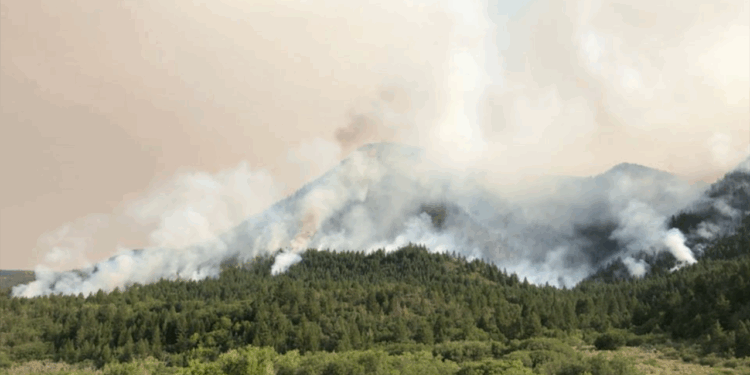The Bear Gulch Fire near Lake Cushman has expanded to 9,657 acres with containment dropping to 10 percent as of Wednesday morning, marking a concerning trend after nearly two months of firefighting efforts.
The blaze has grown substantially from its containment peak of 13 percent on August 25th, illustrating the challenges crews face in steep terrain where fire spreads through drainage systems. Rachel Lipski, public information officer for the Western Washington Type 3 Incident Management Team, explained that the percentage decline reflects geometric realities rather than reduced firefighting capacity.
“What has happened over time is that the fire has continued to grow in these kind of fingers up drainages in really steep country,” Lipski said. “And so what we’ve added perimeter, and then the math problem basically works out to the amount of perimeter that’s contained becoming less.”
Tuesday’s warmer temperatures and dry conditions particularly intensified fire activity near Wagonwheel Lake, demonstrating how weather patterns directly influence wildfire behaviour despite ongoing suppression efforts. The fire’s persistence after two months highlights the complex challenges of battling wildfires in Washington’s mountainous terrain.
Evacuation orders remain in effect for areas near Copper Creek under Level 3 “Go Now” status, including Staircase Campground and areas across the causeway on Lake Cushman’s north side. Cushman Ridge south of the Dry Creek Trail remains under Level 2 “Set” evacuation notice.
Operations continue to rely heavily on helicopter water drops due to terrain limitations that prevent ground crew access to active fire areas. Crews recently removed structure protection wrapping from ranger station buildings at Staircase Campground after six weeks, citing concerns that trapped moisture could damage the wooden structures.
Safety considerations significantly constrain firefighting efforts. National Park Service spokesperson Molly Pittman previously noted that fire-weakened trees create hazardous conditions for ground crews. “We want to make sure the firefighters are safe, so we will not be in those areas that are super hazardous with those falling trees,” she said.
The road to Staircase Campground remains closed due to frequent falling debris, limiting access for both emergency responders and potential evacuees. This closure illustrates how wildfires create cascading safety issues beyond the immediate fire perimeter.
Weather forecasts offer mixed prospects for containment efforts. Whilst Wednesday represents the peak of current warming and drying trends, fire behaviour analysts do not expect substantial near-term growth. Lipski indicated that cooling temperatures and higher relative humidity should help reduce fire activity.
“The forecast suggests that today is basically kind of the apex of our warming and drying trend, and we’re going to kind of turn around and go into more of a cooling trend,” she explained. Rain possibilities early next week could significantly aid containment efforts.
The Bear Gulch Fire’s expansion despite sustained firefighting efforts reflects broader challenges facing wildfire management in the Pacific Northwest. Climate conditions, terrain limitations, and safety constraints create complex operational environments where traditional containment strategies face significant obstacles.
For local communities, the fire’s persistence and expansion underscore the importance of evacuation preparedness and the unpredictable nature of wildfire progression. The mathematical relationship between fire growth and containment percentages also demonstrates why containment figures can decline even during active suppression efforts.
The situation near Lake Cushman highlights how wildfire impacts extend beyond immediate burn areas to affect recreation, transportation, and community safety across broader regions. As crews continue battling the blaze, weather conditions will likely determine whether recent expansion trends continue or begin reversing toward more effective containment.







